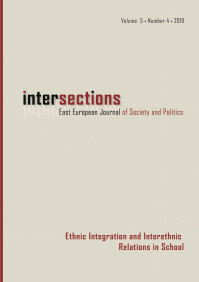
A special edition of Intersections has been published with articles of our members.
Editorial by Dorottya Kisfalusi, Eszter Neumann and Károly Takács entitled "Ethnic Integration and Interethnic Relations in Schools" is available here: https://intersections.tk.mta.hu/index.php/intersections/article/view/683
"The integration of disadvantaged ethnic minorities and children with foreign, refugee and immigrant backgrounds is a key problem in educational policy and social research. The recent wave of refugees into Europe has once again made educational inclusion and structural hospitality a pressing issue for policymakers and practitioners, and also one educational research has a great social responsibility to engage with (De Haene, Neumann and Pataki, 2018). Existing research highlights that even successful integration policies and committed school-level efforts can have limited impact on social integration at the interpersonal, classroom level with few interethnic friendship relations. At the same time, as research has showed, inequalities and prejudices towards ethnic minorities continue to persist even in hospitable and inclusive school environments (Váradi, 2014). This thematic issue presents important contributions that explore these phenomena in different countries using various research methods, including qualitative and quantitative techniques. In addition to studies that provide deeper insight into ethnic integration in schools, some contributions also address policymaking and aim to compare proven recipes and good practices of integration and educational interventions aiming at decreasing persisting inequalities in academic achievement. In line with the general philosophy of Intersections. East European Journal of Society and Politics, the thematic issue is a good example of multidisciplinary, comparative and critical thinking on ethnic integration in schools in different societies. The country-specific studies also contribute to our general scientific understanding of the nature and dynamics of ethnic integration among children of pre-adolescent and adolescent age.
This editorial first attempts to systematize different kinds of explanations for sustaining ethnic inequalities and the reasons behind the failure or limited effectiveness of integration in schools. Afterwards, preventive methods, possible interventions, and policy measures are discussed in light of these explanations. Subsequently, we address how and in which dimensions qualitative contributions in this thematic issue put these questions into new light, and finally we draw implications on how and what kind of explanations are supported by new quantitative results presented in this special issue."
The article "Status Dynamics" by Ákos Bocskor and Anikó Havelda is available here: https://intersections.tk.mta.hu/index.php/intersections/article/view/581
Abstract
Status among peers has been one of the central themes of peer relations research for decades. While the topic has been extensively researched in the Western European and North American literature, less is known about such dynamics in ‘non-Western’ contexts. The paper intends to address this gap by analyzing the status dynamics related to the two most frequently investigated dimensions of status – popularity and acceptance – in a Hungarian, ethnically diverse, longitudinal primary school database. Additionally, we apply a novel multilevel regression model, the within-between random effects model (Bell et al., 2019), which combines the strengths of fixed- and random-effects models and makes the decomposition of within-individual and between-individual effects possible. The paper analyses the first four waves of the panel dataset (N of observations = 4441, N of individuals = 1313). Most of our results are in line with the Western European literature, highlighting the important role of being good at sports, verbal aggression, being considered smart, and physical appearance. With regard to ethnic differences, our results show ethnicized patterns in the relationship between aggression and popularity.


